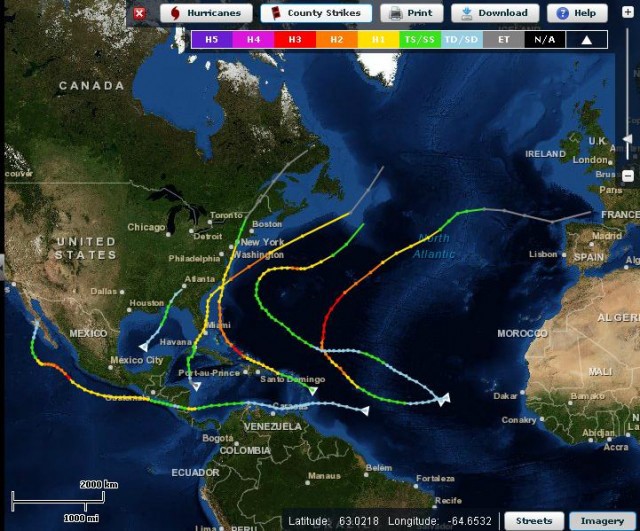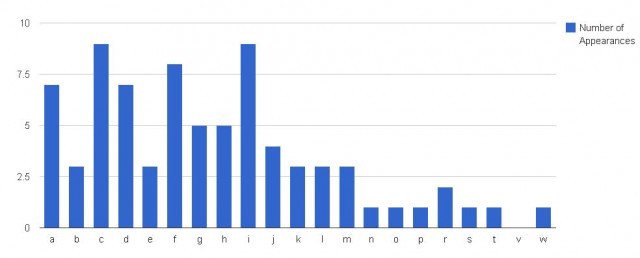Hurricane Names That Spell Trouble: An Unscientific Survey
Hurricane Names That Spell Trouble: An Unscientific Survey

On April 13th of this year, the name Irene was officially retired from the list of Atlantic Basin Hurricane names. In all, six Hurricane Irenes have raged around the Atlantic, but there won’t be a seventh. The screenshot here, taken from NOAA’s Historical Hurricane Tracks (a complete timehole of an application) shows all of the past Atlantic Irenes.* Irene 1971 actually hopped across Nicaragua to become a Pacific storm, Hurricane Olivia, something that’s happened only a handful of times in recorded meteorological history: Irene-Olivia was the first named storm to do so. Irene 1981 struck France. Then Irene 2011 rolled up the East Coast last summer. Clearly, it was only a matter of time before the name was sent to live on a farm.
Irene will be replaced by Irma, who sounds just lovely. But nice, unassuming names can wreak havoc, too. The five strongest hurricanes since we started keeping track are: Camille, Allen, Gilbert, Wilma and Mitch. Hurricane Fifi was responsible for 10,000 deaths. Hurricane Lenny caused $1.24 billion (in today’s dollars) damage. The perceived toughness of a name really reflects nothing about the hurricane itself. So what? Let’s throw our qualms about correlation/causation out the window and see if there are any patterns we can squeeze out of this list of retired storm names!

The World Meteorological Organization in Switzerland decides storm names. Originally, names were nonstandard. Oh, this storm destroyed a boat? Name the storm after the boat! And so on, all very haphazard. For a few years, the phonetic alphabet was used. Then. in 1953, a list of alphabetically organized non-repeating women’s names
were defined to formally christen storms, giving us decades of grandma-sounding hurricanes, like Flossy, Gerda and Ethel. In 1979 the list was amended to alternate with male names and repeat itself every six years. Particularly devastating storms, it was agreed, would have their names “retired,” to prevent future confusion. Retired names are replaced with ones of the same gender and usually origin (Atlantic names come from English, French, and Spanish. So Juan was replaced by Joaquin, Gaston replaced by Georges, etc.). Seventy-six names have been retired so far. There’s been some discussion about whether Gracie, which made landfall in Georgia and South Carolina as a Category 3 storm, is really retired or not, but it’s been off the lists since 1959, and since it’s unlikely to end up used again unless the head of the WMO has a real yen to rile up a bunch of weather nerds, I’ve included it in the count here.
As the six-cycle system was implemented in 1979, we’ll start there. If a greater number of retired names equates to more active seasons, let’s see which name cycles have been more devastating than the others. Are any of them overachievers or total slackers?
Individual cycles (including future years of some because the columns line up so nicely):
A (1979, 1985, 1991, 1997, 2003, 2009): 8 retired names
B (1980, 1986, 1992, 1998, 2004, 2010): 10 retired names
C (1981, 1987, 1993, 1999, 2005, 2011): 8 retired names
D (1982, 1988, 1994, 2000, 2006, 2012): 3 retired names (so far)
E (1983, 1989, 1995, 2001, 2007, 2013): 12 retired names (so far)
F (1984, 1990, 1996, 2002, 2008, 2014): 10 retired names (so far)
As you might expect, things are more or less even (important to note that in Cycle C, five of the seven names were retired in 2005 alone). Does an uneventful history for Cycle D thus far mean we can expect a calm year in 2012? Maybe! The last retiree went down in 2000, so we’re overdue? Maybe! That’s the nice thing about statistics based on meaningless distinctions: draw your own conclusions. Shoot for the moon! If you miss, you’ll burn up in the atmosphere on your agonizing descent.
The name frequencies themselves are a bit more useful, as they’re not on an arbitrary six-year cycle (so we will use the full 1950-onward list), but serve as more of a seasonal indicator. Here’s a chart showing frequency of retired names by letters of the alphabet.

The most retired names are C and I names, with nine each, closely followed by eight Fs and seven As. Of eligible letters, only V remains unretired. This makes sense; most hurricane seasons don’t make it that deep into the WMO’s 21-letter alphabet (no Q, U, X, Y, or Z). V and W named storms didn’t appear at all until 2005 (in the ocean, not on the list. They’ve been on the list, just unused). Personally, I’m hoping for that to change in 2014. Do me proud, Hurricane Vicky!
* There have been a handful of South Pacific Irenes, and the name’s still active for that region.
Previously: How To Not Get Lost
Victoria Johnson devotes the same ardor to hurricane season and hockey season. She is thankful there is only minimal overlap.
